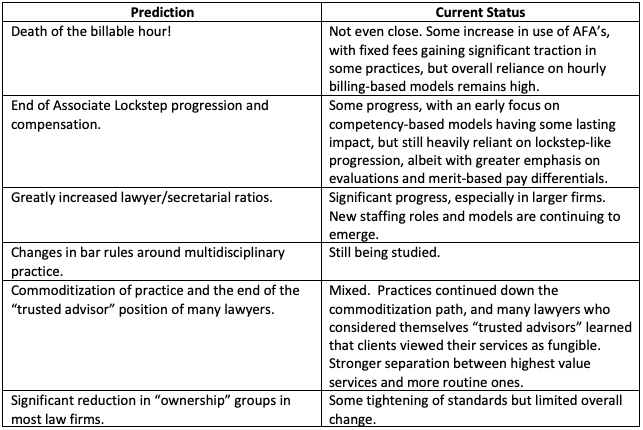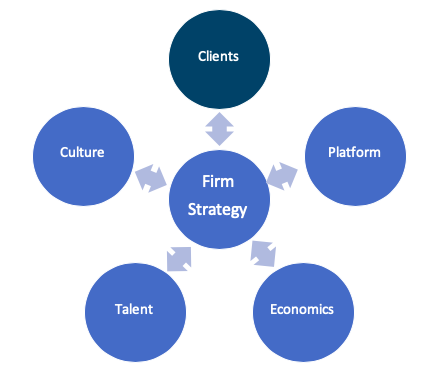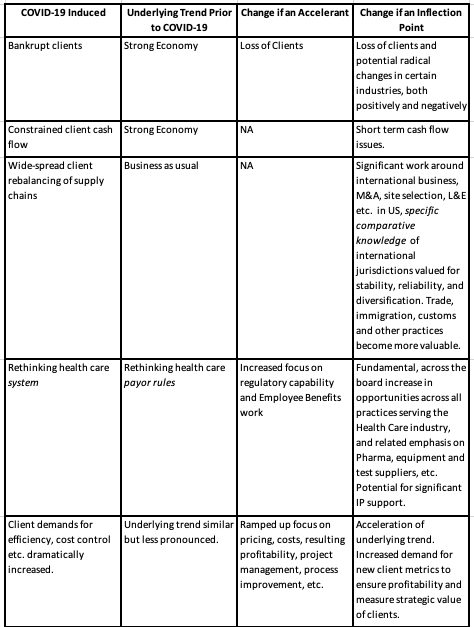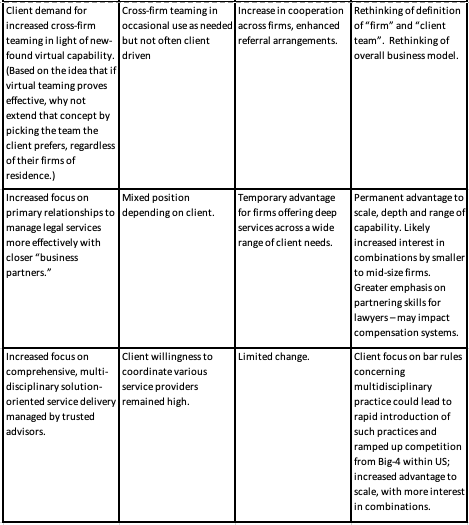By Joe Altonji, Mike Short, Mark Medice and Yvonne Nath
In our COVID-19 Recovery Playbook, we provided our thinking for firm leadership on how to manage through the current crisis. In this four-part continuation of that work, we examine where and how the industry may be shaped by the current health crisis facing the world. In Part 1, we present some thoughts on the types of trends and changes that the crisis has the potential to create in society, and by extension, the legal profession. In Part 2, we look at how client demands might change in light of this pandemic. In Part 3, we look at how these trends might affect the commercial law firm platform. Finally, in Part 4 we discuss how any firm might better prepare itself to weather future “Black Swan” events while coming out the back end in a healthier and better economic position.
Law firms, if they are anything, are organizations devoted to their clients. The lawyers in the best firms understand their clients, their needs and how to serve them. In the end, client demands will always do more to drive change in the profession than any internally generated ideas, although those are still valuable. It is appropriate, therefore, to look first at how the COVID-19 crisis might change the needs and expectations of the clients, and by extension the law firms that serve them. As always, though, we begin with a word of caution about the nature of prediction.
The Danger of Prediction
Over the next several months we are likely to see any number of predictions around how COVID-19 will change the legal industry. Most of them are likely to be wrong, or vastly overstated by agenda-pushers, particularly if this pandemic turns out to be more of an accelerant of change, rather than a true inflection point for societal change (See Part 1 of this series). For example, the entire industry is not going to switch to a completely remote working model, just as the entire industry did not switch entirely from hours-based billing models to alternative fee arrangements (AFA’s) as some experts predicted (or wanted) coming out of the 2008/2009 financial meltdown.
It’s instructive to think back to lessons learned from the “Great Recession.” This event changed the industry, but more by accelerating trends already in place rather than creating fundamentally new and different outcomes. By way of example, in the following table we present a number of predictions promulgated in the wake of that event, as well as comments on where we are now:
Predictions and Outcomes from the Great Recession
What did happen in the Great Recession was a shift in the power relationship between the clients and their outside legal providers, which accelerated an underlying trend toward increased efficiency and cost effectiveness. This shift was enhanced by the growing sophistication of technological tools available to the clients and their law firms to better manage service delivery and allow clients to better manage their providers. For a time, the clients kept a strict hand on the reigns, but over time we reached (at least prior to COVID-19) a better balance in how clients and law firms work together, including significant cooperation and coordination between both parties around legal operations and procurement functions, among other areas.
What Might Occur as a Result of COVID-19?
As we think about the changes that might be emerge from this pandemic, we believe it is useful to both group them by major area of influence, as well as compare them to the underlying trends we saw prior to the onset of the pandemic. We can then consider the degree to which each change is likely to be significant, and how it might play out in terms of changes for law firms, under two scenarios: First, if the COVID-19 pandemic is more of an accelerant to the underlying trends prior to the pandemic, and second, if the pandemic turns out to be more of an inflection point for society and the legal industry.
In thinking through these potential changes, we organized them around the following five major areas where we believe the potential for new trends will be most evident or old trends accelerated.
Areas of Trend Potential
The impact on law firms will often go beyond the core area that captures the trend. For example, a trend on the client side might have law firm impacts that are economic, or structural. In the remainder of our analyses, we placed each in a primary area to simplify the structure of our work.
Client-Focused Considerations: We begin with the clients because, as always, clients will continue to be the primary drivers of change in the legal world. Law firms, by their nature, are cautious, precedential organizations with some influential Partners who usually resist change unless it is demanded or forced by their clients. Some of the trends and changes we suggest are obvious, but others are more speculative and based on possible changes in perspective that have not yet emerged but can be viewed as a potential extension of more obvious changes.
Of course, the trends above do not capture all the potential client opportunities that will fall to law firms as a result of the current COVID-19 crisis. In the short term there are, of course, a wide range of practices that are not only busy but, in many cases, taxed to the extreme in terms of demand, such as Labor & Employment, aspects of Government Regulation, Creditor Relationships, Restructuring and other areas. These will continue, but over time we also anticipate a strong up-tick in litigation (including insurance coverage and recovery), material tort defense (absent blanket moves by government to confer immunity around various potential areas), Trust & Estate/Wealth Transition, Immigration, Customs, Government Contracting and many others. After a short blip, we anticipate that the legal industry, taken as a whole, will see an increase in demand of some significance, much of which will endure for several years, if not permanently.
In our next installment, we examine changes associated with the remaining four areas in our diagram (above) – culture, talent, economics, and platform.






